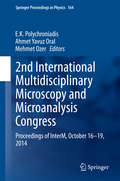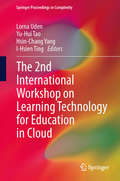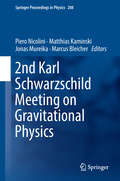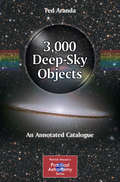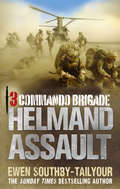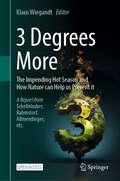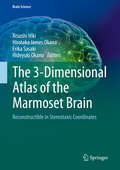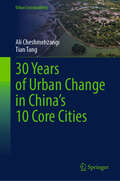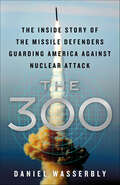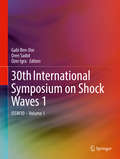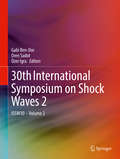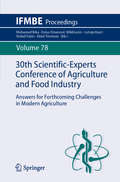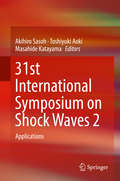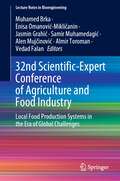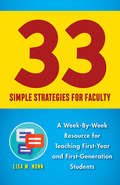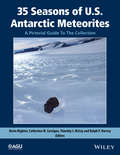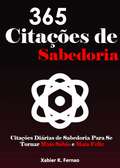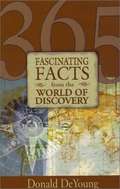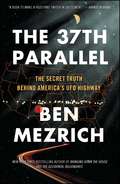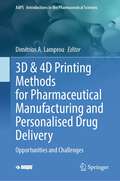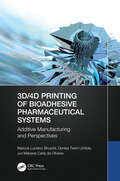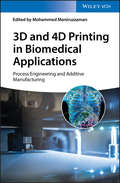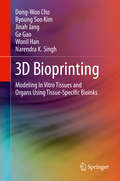- Table View
- List View
2nd International Multidisciplinary Microscopy and Microanalysis Congress: Proceedings of InterM, October 16-19, 2014 (Springer Proceedings in Physics #164)
by E. K. Polychroniadis Ahmet Yavuz Oral Mehmet OzerThe 2nd International Multidisciplinary Microscopy and Microanalysis Congress & Exhibition (InterM 2014) was held on 16-19 October 2014 in Oludeniz, Fethiye/ Mugla, Turkey. The aim of the congress was to gather scientists from various branches and discuss the latest improvements in the field of microscopy. The focus of the congress has been widened in an "interdisciplinary" manner, so as to allow all scientists working on several related subjects to participate and present their work. These proceedings include 33 peer-reviewed technical papers, submitted by leading academic and research institutions from over 17 countries and representing some of the most cutting-edge research available. The papers were presented at the congress in the following sessions: #65533; Applications of Microscopy in the Physical Sciences #65533; Applications of Microscopy in the Biological Sciences
The 2nd International Workshop on Learning Technology for Education in Cloud
by Lorna Uden I-Hsien Ting Hsin-Chang Yang Yu-Hui TaoProceedings from the 2013 LTEC conference in Kaohsiung, Taiwan. The papers examine diverse aspects of Learning Technology for Education in Cloud environments, including social, technical and infrastructure implications. Also addressed is the question of how cloud computing can be used to design applications to support real time on demand learning using technologies. The workshop proceedings provide opportunities for delegates to discuss the latest research in TEL (Technology Enhanced Learning) and its impacts for learners and institutions, using cloud technologies.
2nd Karl Schwarzschild Meeting on Gravitational Physics (Springer Proceedings in Physics #208)
by Piero Nicolini Matthias Kaminski Jonas Mureika Marcus BleicherThis book presents the proceedings of the 2nd Karl Schwarzschild Meeting on Gravitational Physics, focused on the general theme of black holes, gravity and information.Specialists in the field of black hole physics and rising young researchers present the latest findings on the broad topic of black holes, gravity, and information, highlighting its applications to astrophysics, cosmology, particle physics, and strongly correlated systems.
3,000 Deep-Sky Objects: An Annotated Catalogue (The Patrick Moore Practical Astronomy Series)
by Ted ArandaThis title is a comprehensive set of visual descriptions of deep-sky objects visible from the northern hemisphere. It is a record of the most extensive and systematic visual survey of the sky ever done in modern times. 3,000 deep-sky objects are listed with short descriptions of the visual appearance in the author's powerful binocular telescope. Objects in the book are organized by position for easy identification of unknown targets. Full indexes by catalog numbers and names allow searches for specific objects.
3 Commando: Helmand Assault
by Ewen Southby-TailyourWhen the Royal Marines Commandos returned to a chaotic Helmand in the winter of 2008, they realised that to stand any chance of success they would need to pursue an increasingly determined Taliban harder than ever before. This time they were going to hunt them down from the air. With the support of Chinooks, Apaches, Lynx, Sea Kings and Harriers, the Commandos became a deadly mobile unit, able to swoop at a moments notice into the most hostile territory.From huge operations like the gruelling Red Dagger, when 3 Commando Brigade fought in Somme-like mud to successfully clear the area around the capital of Helmand, Lashkar Gar, of encroaching enemy forces, to the daily acts of unsupported, close-quarters 360-degree combat and the breath-taking, rapid helicopter night assaults behind enemy lines - this was kind of battle that brought Commando qualities to the fore. As with the Sunday Times bestselling 3 Commando Brigade, ex-Marine Lieutenant Colonel Ewen Southby-Tailyour brings unparalleled access to the troops, a soldier's understanding of the conflict and a visceral sense of the combat experience. This is the real war in Afghanistan as told to him by a hand-picked band of young fellow marines as they encounter the daily rigours of life on the ground in the world's most intense war zone.
3 Degrees More: The Impending Hot Season and How Nature Can Help Us Prevent It
by Klaus WiegandtThis open access book describes in detail what life on this planet would be like if its average surface temperature were to rise 3 degrees Celsius above the preindustrial level. On this basis, the book argues that it is imperative to keep this temperature rise below 2 degrees Celsius. It then lays out a detailed plan of what politically feasible, cost-effective measures should now be taken to achieve this goal. In this context, the book provides detailed discussions of climate finance, climate education and nature-based solutions. The book has been translated into English from the original German version published in 2022, and contains an original foreword and preface.
The 3-Dimensional Atlas of the Marmoset Brain: Reconstructible In Stereotaxic Coordinates (Brain Science)
by Atsushi Iriki Hirotaka James Okano Erika Sasaki Hideyuki OkanoThis book provides accurate, comprehensive, and convenient reference for usages of the “freely rotatable three dimensional combined Nissl-stained and MRI digital data of the marmoset brain”. The key features of the original 3D digital data and of this atlas are: 1. The original digital datasets are freely rotatable in three dimensions, thus expected to be useful for any disciplines and anatomical interest, using any coordinate system, 2. Combined Nissl stained and MRI images are obtained from the same marmoset, to allow cross-modality matched references for multiple usages, 3. 86 Horizontal Series of Images with Neurosurgical Plane (based on the actual data), with more accuracy and resolution (Chapter 2) than the web-based digital images, 4. 32 Coronal Series of Images with Neurosurgical Plane (reproduced from the brain model) (Chapter 3), 5. 10 Parasagittal Series of Images with Neurosurgical Plane (reproduced from the brain model) (Chapter 4), 6. 3 Omnidirectionally Sliceable Planes (reproduced from the brain model) (Chapter 5), 7. In order to provide higher resolution structures to match systematic accuracy for supplementation of the digital data on the website, additional information are included. They are: 1) Nomenclature, 2) List of Brain Structures in Hierarchical Order, 3) Index of Abbreviations, together with 143 useful Bibliographic References list as of 2016, 8. Horsley-Clarke’s stereotaxic coordinates were adopted in the present atlas.
30 Years of Urban Change in China’s 10 Core Cities (Urban Sustainability)
by Ali Cheshmehzangi Tian TangAs a continuation of our award-winning book ‘China's City Cluster Development in the Race to Carbon Neutrality’, this book covers China's major urban changes over the last 30 years. Unlike the previous book, where we highlighted regional development issues, this book explicitly explores the city cases, particularly those that are considered core cities in China. Based on the micro-historical analysis of China's urbanization trend and urban development patterns, we see that cities in China have played a significant role in driving the country's sustainable development agenda. In a way, they have had both positive and negative impacts on achieving sustainable development. We look at these last three decades mainly because, during this period, China's urbanization became unprecedented, the central government made several pledges and signed many international agreements related to sustainable development, and China grew rapidly to become the second global economic power. Aligned with the overarching Belt and Road Initiative (BRI) and the more recent Carbon Neutrality Plan (CNP), Chinese core cities played a significant part in regional development, urban-rural relations, industrial clustering, the development of free trade zones and special economic zones, etc. All these recent developments are due to China's ongoing urbanization and urban development. ‘30 Years of Urban Change in China’s 10 Core Cities’ is a mapping study of China's core cities and their changes over three decades of rapid urbanization, urban growth, and economic development. We explicitly highlight each selected city’s development trends, sustainable development plans, and major strategies. In this Volume (out of our two ‘connected’ volumes), we summarise lessons learnt from all 10 case study examples, and we hope they can be utilized for other developing and rapidly urbanizing nations. We expect this book to be a valuable resource for local governments, authorities, urban planners, urbanists, practitioners, developers, and urban researchers. We trust China is no longer a developing country, and much of these recent progressions are owed to its structured urban development strategies, robust governmental structure, and progressive attitude to growth and development. Hence, this topic coverage at the point where China's urbanization is shifting to high-quality urbanization is essential and beneficial to multiple stakeholders.
The 300: The Inside Story of the Missile Defenders Guarding America Against Nuclear Attack
by Daniel WasserblyMilitary and security expert Daniel Wasserbly introduces the elite unit tasked with protecting the nation from long-range weapons of mass destruction.Comprised of just three hundred soldiers, the United States Army’s 100th Missile Defense Brigade and 49th Missile Defense Battalion utilize sophisticated and cutting-edge technology to monitor the skies and seas surrounding the country and shield three hundred million Americans against any potential nuclear threat. Named for the number of Spartan warriors who defended Greece at the Battle of Thermopylae, these vigilant individuals endure rigorous, always-evolving regimens to maintain peak efficiency in the event of an actual nuclear strike.Assigned to extraordinary locations at Fort Greely, Alaska and Schriever Air Force Base, Colorado, the 300 are responsible for the highest levels of homeland security. They not only maintain a never-ending watch via radar and sensor arrays, but receive continuous training in operating advanced interceptors designed to home in on and destroy in-flight ballistic missiles. It’s a complex—and occasionally unreliable—defense system that scientists and engineers are always improving and upgrading.With unprecedented access to the highly classified strategic nerve centers of U.S. Northern Command in Cheyenne Mountain, years of research, and dozens of exclusive interviews with normally inaccessible missile crews, Wasserbly reveals the incredible true story behind the 300’s essential defense operations.
30th International Symposium on Shock Waves 1: ISSW30 - Volume 1
by Ozer Igra Gabi Ben-Dor Oren SadotThese proceedings collect the papers presented at the 30th International Symposium on Shock Waves (ISSW30), which was held in Tel-Aviv Israel from July 19 to July 24, 2015. The Symposium was organized by Ortra Ltd. The ISSW30 focused on the state of knowledge of the following areas: Nozzle Flow, Supersonic and Hypersonic Flows with Shocks, Supersonic Jets, Chemical Kinetics, Chemical Reacting Flows, Detonation, Combustion, Ignition, Shock Wave Reflection and Interaction, Shock Wave Interaction with Obstacles, Shock Wave Interaction with Porous Media, Shock Wave Interaction with Granular Media, Shock Wave Interaction with Dusty Media, Plasma, Magnetohyrdrodynamics, Re-entry to Earth Atmosphere, Shock Waves in Rarefied Gases, Shock Waves in Condensed Matter (Solids and Liquids), Shock Waves in Dense Gases, Shock Wave Focusing, Richtmyer-Meshkov Instability, Shock Boundary Layer Interaction, Multiphase Flow, Blast Waves, Facilities, Flow Visualization, and Numerical Methods. The two volumes serve as a reference for the participants of the ISSW30 and anyone interested in these fields.
30th International Symposium on Shock Waves 2: ISSW30 - Volume 2
by Ozer Igra Gabi Ben-Dor Oren SadotThese proceedings collect the papers presented at the 30th International Symposium on Shock Waves (ISSW30), which was held in Tel-Aviv Israel from July 19 to July 24, 2015. The Symposium was organized by Ortra Ltd. The ISSW30 focused on the state of knowledge of the following areas: Nozzle Flow, Supersonic and Hypersonic Flows with Shocks, Supersonic Jets, Chemical Kinetics, Chemical Reacting Flows, Detonation, Combustion, Ignition, Shock Wave Reflection and Interaction, Shock Wave Interaction with Obstacles, Shock Wave Interaction with Porous Media, Shock Wave Interaction with Granular Media, Shock Wave Interaction with Dusty Media, Plasma, Magnetohyrdrodynamics, Re-entry to Earth Atmosphere, Shock Waves in Rarefied Gases, Shock Waves in Condensed Matter (Solids and Liquids), Shock Waves in Dense Gases, Shock Wave Focusing, Richtmyer-Meshkov Instability, Shock Boundary Layer Interaction, Multiphase Flow, Blast Waves, Facilities, Flow Visualization, and Numerical Methods. The two volumes serve as a reference for the participants of the ISSW30 and anyone interested in these fields.
30th Scientific-Experts Conference of Agriculture and Food Industry: Answers for Forthcoming Challenges in Modern Agriculture (IFMBE Proceedings #78)
by Enisa Omanović-Mikličanin Muhamed Brka Lutvija Karić Vedad Falan Almir ToromanThis book gathers the proceedings of the 30th Scientific-Experts Conference of Agriculture and Food Industry, held on September 26-27, 2019, in Sarajevo, Bosnia and Herzegovina. It reports on the application of innovative technologies in food sciences and agriculture, and covers research in plant and animal production, agricultural economics and food production. Further, the book discusses key social and environmental issues, and proposes answers to current challenges. The conference was jointly organized by the Faculty of Agriculture and Food Sciences of the University of Sarajevo, Bosnia and Herzegovina, the Faculty of Agriculture of Ege University, Turkey, the Bosnia and Herzegovina Medical and Biological Engineering Society, and the Faculty of Agriculture of the University of Belgrade, Serbia. The proceedings offer a timely snapshot of cutting-edge, multidisciplinary research and developments in modern agriculture. As such, they address the needs of researchers and professionals, agricultural companies, food producers, and regulatory and food safety agencies.
31st International Symposium on Shock Waves 2: Applications
by Akihiro Sasoh Toshiyuki Aoki Masahide KatayamaThis is the second volume of a two volume set which presents the results of the 31st International Symposium on Shock Waves (ISSW31), held in Nagoya, Japan in 2017. It was organized with support from the International Shock Wave Institute (ISWI), Shock Wave Research Society of Japan, School of Engineering of Nagoya University, and other societies, organizations, governments and industry. The ISSW31 focused on the following areas: Blast waves, chemical reacting flows, chemical kinetics, detonation and combustion, ignition, facilities, diagnostics, flow visualization, spectroscopy, numerical methods, shock waves in rarefied flows, shock waves in dense gases, shock waves in liquids, shock waves in solids, impact and compaction, supersonic jet, multiphase flow, plasmas, magnetohyrdrodynamics, propulsion, shock waves in internal flows, pseudo-shock wave and shock train, nozzle flow, re-entry gasdynamics, shock waves in space, Richtmyer-Meshkov instability, shock/boundary layer interaction, shock/vortex interaction, shock wave reflection/interaction, shock wave interaction with dusty media, shock wave interaction with granular media, shock wave interaction with porous media, shock wave interaction with obstacles, supersonic and hypersonic flows, sonic boom, shock wave focusing, safety against shock loading, shock waves for material processing, shock-like phenomena, and shock wave education. These proceedings contain the papers presented at the symposium and serve as a reference for the participants of the ISSW 31 and individuals interested in these fields.
32nd Scientific-Expert Conference of Agriculture and Food Industry: Local Food Production Systems in the Era of Global Challenges (Lecture Notes in Bioengineering)
by Muhamed Brka Enisa Omanović-Mikličanin Jasmin Grahić Samir Muhamedagić Alen Mujčinović Almir Toroman Vedad FalanThis book gathers the proceedings of the 32nd Scientific-Experts Conference of Agriculture and Food Industry, held on December 1-2, 2022, in Sarajevo, Bosnia and Herzegovina. It reports on the application of molecular, nano- and engineering technologies for food sciences, and plant and animal production. It discusses important agricultural economics and social and environmental issues, proposings some answers to current and future challenges. The chapters reflect the special focus of this conference edition, which was on discussing strategies for developing a more resilient and sustainable agrifood systems. Offering a timely snapshot of cutting-edge and multidisciplinary research and methods, this book addresses researchers, professionals, and stakeholders in the broad field of agriculture and food sciences, biotechnology, and bio- and nanoengineering.
33 Simple Strategies for Faculty: A Week-By-Week Resource for Teaching First-Year and First-Generation Students
by Lisa M. NunnMany students struggle with the transition from high school to university life. This is especially true of first-generation college students, who are often unfamiliar with the norms and expectations of academia. College professors usually want to help, but many feel overwhelmed by the prospect of making extra time in their already hectic schedules to meet with these struggling students. 33 Simple Strategies for Faculty is a guidebook filled with practical solutions to this problem. It gives college faculty concrete exercises and tools they can use both inside and outside of the classroom to effectively bolster the academic success and wellbeing of their students. To devise these strategies, educational sociologist Lisa M. Nunn talked with a variety of first-year college students, learning what they find baffling and frustrating about their classes, as well as what they love about their professors’ teaching. Combining student perspectives with the latest research on bridging the academic achievement gap, she shows how professors can make a difference by spending as little as fifteen minutes a week helping their students acculturate to college life. Whether you are a new faculty member or a tenured professor, you are sure to find 33 Simple Strategies for Faculty to be an invaluable resource.
35 Seasons of U.S. Antarctic Meteorites (1976-2010)
by Catherine Corrigan Ralph Harvey Kevin Righter Timothy MccoyThe US Antarctic meteorite collection exists due to a cooperative program involving the National Science Foundation (NSF), the National Aeronautics and Space Administration (NASA), and the Smithsonian Institution. Since 1976, meteorites have been collected by a NSF-funded field team, shipped for curation, characterization, distribution, and storage at NASA, and classified and stored for long term at the Smithsonian. It is the largest collection in the world with many significant samples including lunar, martian, many interesting chondrites and achondrites, and even several unusual one-of-a-kind meteorites from as yet unidentified parent bodies. Many Antarctic meteorites have helped to define new meteorite groups. No previous formal publication has covered the entire collection, and an overall summary of its impact and significant samples has been lacking. In addition, available statistics for the collection are out of date and need to be updated for the use of the community. 35 seasons of U.S. Antarctic Meteorites (1976-2011): A Pictorial Guide to the Collection is the first comprehensive volume that portrays the most updated key significant meteoritic samples from Antarctica.35 seasons of U.S. Antarctic Meteorites presents a broad overview of the program and collection nearly four decades after its beginnings. The collection has been a consistent and reliable source of astromaterials for a large, diverse, and active scientific community. Volume highlights include:* Overview of the history, field practices, curation approaches* Special focus on specific meteorite types and the impact of the collection on understanding these groups (primitive chondrites, differentiated meteorites, lunar and martian meteorites)* Role of Antarctic meteorites in influencing the determination of space and terrestrial exposure ages for meteorites* Statistical summary of the collection by year, region, meteorite type, as well as a comparison to modern falls and hot desert finds* The central portion of the book features 80 color plates each of which highlights more influential and interesting samples from the collection.35 seasons of U.S. Antarctic Meteorites would be of special interest to a multidisciplinary audience in meteoritics, including advanced graduate students and geoscientists specializing in mineralogy, petrology, geochemistry, astronomy, near-earth object science, astrophysics, and astrobiology.
365 Citações de Sabedoria: Citações Diárias de Sabedoria Para Se Tornar Mais Sábio e Mais Feliz
by Xabier K. FernaoVocê preferiria aprender 30 anos de lições com as vidas de outras pessoas, ou viver 30 anos para aprender estas lições? Pense nisto. O que estou essencialmente perguntando é... Por que não aprender com as falhas, sucessos e experiências de vida de outras pessoas? Foi Sócrates, um dos maiores filósofos gregos que disse... “A verdadeira sabedoria chega para cada um de nós quando percebemos o quão pouco entendemos sobre a vida, sobre nós mesmos e sobre o mundo ao nosso redor." Não é verdade que não precisamos ler um livro imenso com muitos jargões e termos técnicos para se tornar mais sábio, mais consciente e ter mais paz? É por isto que este livro de 365 Citações de Sabedoria é tão importante.
365 Citaten van Wijsheid: Dagelijkse citaten van wijsheid om wijzer en gelukkiger te worden
by Xabier K. FernaoSchokkende statistieken: Een Gemiddelde Amerikaan Leest 1 Boek per Jaar en 50% daarvan zijn Romantische Romans.... Kijk, ik weet niet wie je bent, maar ik weet zeker dat je nu deze pagina leest, omdat je iemand bent die meer wil. Je bent iemand die geen genoegen neemt met het gemiddelde. Zie je, ik begrijp de wens om te willen leren maar tegelijkertijd op te zien tegen het lezen van een lijvig en dik boek! Daarom hebben we dit boek gemaakt.... Meer over dit boek: Zou je liever een les leren dank zij de 30 jaar levenservaring van anderen of 30 jaar leven om diezelfde les te leren? Denk daar eens over na. Wat ik je eigenlijk vraag is… waarom niet leren van de mislukkingen, successen en levenservaringen van andere mensen? Het was Socrates, een van de grootste Griekse filosofen die zei dat… "Echte Wijsheid Komt tot Ieder van Ons Wanneer We Beseffen Hoe Weinig We Begrijpen van het Leven, Onszelf en de Wereld om ons Heen". Het is toch zo, dat we echt geen lijvig boek vol met jargon en techniciteiten moeten lezen om wijzer, bewuster en vredelievender te worden? Dat is waarom dit 365 Citaten van Wijsheid boek zo belangrijk is. Dat is het mooie van Citaten. Kort, Simpel en Krachtig. Ik hoop en vertrouw er op dat je deze echt korte introductie tot dit boek wel fijn vond. Lees de citaten, gebruik ze, doe er gretig beroep op en maak ze tot je vrienden. Reageer nu door te klikken op de "Koop nu in 1-klik" knop bovenaan deze pagina! P.S. Hier is nog een andere schokkende statistiek: "50% van de Amerikaanse volwassenen kan geen boek lezen dat geschreven is op het niveau van de lagere humaniora.". P.P.S. Ik weet absoluut dat deze statistieken niet op jou van toepassing zijn. Reageer Nu door te Klikken op de "Koop nu in 1-klik" knop bovenaan deze pagina!
365 Fascinating Facts from the World of Discovery
by Donald B. DeYoungAn engaging look at significant discoveries through the centuries, mostly geared around science and invention. Dr. DeYoung uses his astronomy background as a basis for sharing many significant events down through the years, and adds to the mix with facts related to many different areas of science. This compilation of short facts will thrill trivia enthusiasts and are designed to help the reader commit them quickly to memory.
The 37th Parallel: The Secret Truth Behind America's UFO Highway
by Ben MezrichThis real-life The X-Files and Close Encounters of the Third Kind tells the true story of a computer programmer who tracks paranormal events along a 3,000-mile stretch through the heart of America and is drawn deeper and deeper into a vast conspiracy.Like "Agent Mulder" of The X-Files, computer programmer and sheriff's deputy Zukowski is obsessed with tracking down UFO reports in Colorado. He would take the family with him on weekend trips to look for evidence of aliens. But this innocent hobby takes on a sinister urgency when Zukowski learns of mutilated livestock, and sees the bodies of dead horses and cattle--whose exsanguination is inexplicable by any known human or animal means. Along an expanse of land stretching across the southern borders of Utah, Colorado, and Kansas, Zukowski discovers multiple bizarre incidences of mutilations, and suddenly realizes that they cluster around the 37th Parallel or "UFO Highway." So begins an extraordinary and fascinating journey from El Paso and Rush, Colorado, to a mysterious space studies company and MUFON, from Roswell and Area 51 to the Pentagon and beyond; to underground secret military caverns and Indian sacred sites; beneath strange, unexplained lights in the sky and into corporations that obstruct and try to take over investigations. Inspiring and terrifying, this true story will keep you up at night, staring at the sky, and wondering if we really are alone...and what could happen next.
3D & 4D Printing Methods for Pharmaceutical Manufacturing and Personalised Drug Delivery: Opportunities and Challenges (AAPS Introductions in the Pharmaceutical Sciences #11)
by Dimitrios A. LamprouNew materials and manufacturing techniques are emerging with potential to address the challenges associated with the manufacture of pharmaceutical systems that will teach new tricks to old drugs. 3D printing (3DP) is a technique that can used for the manufacturing of dosage forms, and especially targeting paediatric and geriatric formulations, as permits the fabrication of high degrees of complexity with great reproducibility, in a fast and cost-effective fashion, and offers a new paradigm for the direct manufacture of personalised dosage forms. The book is covering the basics behind each additive manufacturing (AM) method, current applications in pharmaceutics for each 3DP method, and case studies (examples) from a teaching perspective, targeting undergraduate (UG) and postgraduate (PG) students. A unique to this book is the integration of studies based upon the use of different AM technologies, which designed to reinforce importance printing parameters and material considerations. The book includes case studies or multiple-choice questions (MCQs), which allow application of the content in a flipped-classroom.
3D/4D Printing of Bioadhesive Pharmaceutical Systems: Additive Manufacturing and Perspectives
by Marcos Luciano Bruschi Denise Tiemi Uchida Mariana Carla de OliveiraThis book features a brief history of additive manufacturing and 3D/4D printing techniques, as well as the advantages, applications, and overall challenges facing the technology. It then focuses on the applications of bioadhesive systems for drug delivery.3D/4D Printing of Bioadhesive Pharmaceutical Systems: Additive Manufacturing and Perspectives, explores recent discoveries of 3D printing in the development of pharmaceutical systems and drug delivery. Specifically, it discusses the main polymers/materials used in the development of bio-adhesive pharmaceutical systems and explains the importance of bio-adhesiveness of drug release through 3D printing. The authors also introduce the main strategies necessary to achieve a proper drug delivery system through 3D printing, and examine the adhesiveness of these systems on the skin as the mucosa decreases with the elimination of the drug by the body. Finally, the book brings all the necessary specifications to obtain a bioadhesive system with suitable bio-ink to obtain the best 3D/4D printing.This book is written with the objective of helping students start their studies in pharmaceutical engineering, bioengineering and additive manufacturing. Moreover, engineering professionals can use the book to improve the performance of 3D/4D printers for this type of system.
3D and 4D Printing in Biomedical Applications: Process Engineering and Additive Manufacturing
by Mohammed ManiruzzamanA professional guide to 3D and 4D printing technology in the biomedical and pharmaceutical fields 3D and 4D Printing in Biomedical Applications offers an authoritative guide to 3D and 4D printing technology in the biomedical and pharmaceutical arenas. With contributions from an international panel of academic scholars and industry experts, this book contains an overview of the topic and the most current research and innovations in pharmaceutical and biomedical applications. This important volume explores the process optimization, innovation process, engineering, and platform technology behind printed medicine. In addition, information on biomedical developments include topics such as on shape memory polymers, 4D bio-fabrications and bone printing. The book covers a wealth of relevant topics including information on the potential of 3D printing for pharmaceutical drug delivery, examines a new fabrication process, bio-scaffolding, and reviews the most current trends and challenges in biofabrication for 3D and 4D bioprinting. This vital resource: -Offers a comprehensive guide to 3D and 4D printing technology in the biomedical and pharmaceutical fields -Includes information on the first 3D printing platform to get FDA approval for a pharmaceutical product -Contains a review of the current 3D printed pharmaceutical products -Presents recent advances of novel materials for 3D/4D printing and biomedical applications Written for pharmaceutical chemists, medicinal chemists, biotechnologists, pharma engineers, 3D and 4D Printing in Biomedical Applications explores the key aspects of the printing of medical and pharmaceutical products and the challenges and advances associated with their development.
3D Bioprinting: Modeling In Vitro Tissues and Organs Using Tissue-Specific Bioinks
by Dong-Woo Cho Byoung Soo Kim Jinah Jang Ge Gao Wonil Han Narendra K. SinghThis text advances fundamental knowledge in modeling in vitro tissues/organs as an alternative to 2D cell culture and animal testing. Prior to engineering in vitro tissues/organs,the descriptions of prerequisites (from pre-processing to post-processing) in modeling in vitro tissues/organs are discussed. The most prevalent technologies that have been widely used for establishing the in vitro tissue/organ models are also described, including transwell, cell spheroids/sheets, organoids, and microfluidic-based chips. In particular, the authors focus on 3D bioprinting in vitro tissue/organ models using tissue-specific bioinks. Several representative bioprinting methods and conventional bioinks are introduced. As a bioink source, decellularized extracellular matrix (dECM) are importantly covered, including decellularization methods, evaluation methods for demonstrating successful decellularization, and material safety. Taken together, the authors delineate various application examples of 3D bioprinted in vitro tissue/organ models especially using dECM bioinks.
